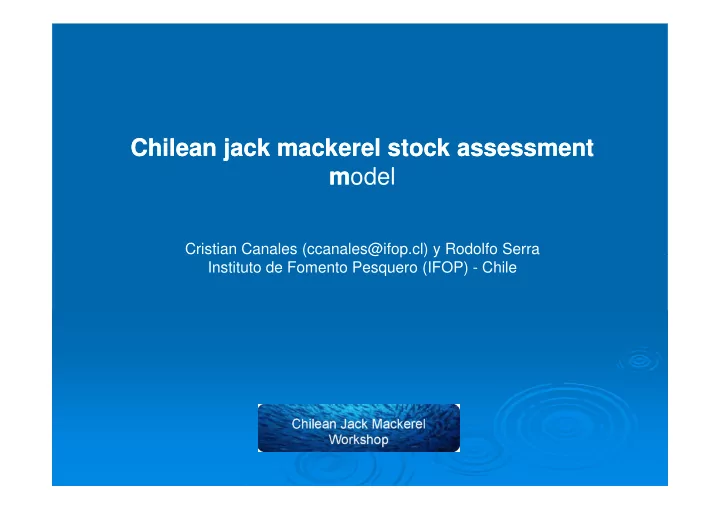

Chilean Chilean jack jack mackerel mackerel stock stock assessment assessment m odel Cristian Canales (ccanales@ifop.cl) y Rodolfo Serra Cristian Canales (ccanales@ifop.cl) y Rodolfo Serra Instituto de Fomento Pesquero (IFOP) - Chile
Stock Stock structure structure hypotesis hypotesis Recruitments zone Spawning zone Feeding zone >105° W
Stochastic Stochastic modeling modeling •There are error sources in the data collection. Then, this information is an imperfect representation of the population •This approximation implies to assume different likelihood functions for modeling, for example, the observation error •The Chilean jack mackerel assessment is done considering this type of approximation
Stochastic Stochastic modeling modeling Parameters ( θ ) Data collection Previous knowldge Population dynamics model Information and indexes Ej CPUE obs Observation model Ej. CPUE pred = G(x,y,z, θ ) Error model f=G(CPUE pred – CPUE obs ) no f minimum ? (Maximum Likelihood) End
Information Information employed employed • Estimates of growth, maturity, and natural mortality (M=0.23) parameters. • Landings for the northern and central-southern fleets (1975-2007). • Age at catch (2 - 12+ years) matrices per fleet/zone. The length compositions data from ex-URSS fleet, were assumed to be similar to the data collected in the central southern zone of Chile. • Average weight at age matrices. • Average weight at age matrices. • Age compositions from the acoustic cruises (1997-2006) in the central- southern zone. • Acoustic biomass (1997-2007). • Spawning biomass indices estimated by the Daily Egg Production Method (DEPM) (1999- 2001; 2003-2006). • CPUE for the central-southern purse seine fleet (1996-2003).
Space Space considerations considerations Catch-at-age •There is an age-specific 5 x 10 6 migration process, from Northern zone northern Chile towards 4 central- south area. This is a gradual process that occur 2 when the fish have 4-5 years 0 old 2 3 4 5 6 7 8 9 10 11 12 5 x 10 10 8 Southern zone •This means that, in the 6 northern area, the older fish 4 are less available for 2 exploitation. Complementary, 0 in the central-south area the 2 3 4 5 6 7 8 9 10 11 12 Age (year) fish are full exploitated since 7 years old
Main Main modelling modelling considerations considerations Selectivity Selectivity Northern Northern area area Southern Southern area area − 1 1 f 2 − a a − − µ ( a ) 50 %, t − ln( 19 ) t 2 f 2 s ∆ f f = = + S e S 1 e t t a , t a , t 1 North South 0.8 0.6 Selectivity 0.4 0.2 0 2 4 6 8 10 12 Age (year)
Main Main modelling modelling considerations considerations Acoustic Acoustic catchability catchability hypothesis hypothesis B c c =q c * B * B B 1 ∑ y 1) 1) Change Change in in distribution distribution: : c = q exp log y ˆ n B i y 2) Contraction 2) 2) 2) Contraction Contraction of Contraction of of biomass of biomass biomass: biomass: : : < y 2002 B 1 ∑ y exp log ˆ ∈ − B [5 400] mn n B i y y = c q y ≥ y 2002 ˆ λ η B y ∈ − B [5 200] mn y
Main Main results results
Main Main results results
Testing Testing hypotesis hypotesis Hypotesis SSB (ton) SSB/SSBo -log Like p AIC S1=Distribution change 4,807,400 0.2697 4,360 61 8842 S2= Contraction of biomass distribution 4,083,400 0.2418 4,372 63 8871 SSB: Spawning biomass, SSBo: Virginal Spawning biomass, -log Like: - log likelihood, p: parameters number, AIC: Akaike information criterion Even in the most optimistic of cases (S1), the population is reduced Even in the most optimistic of cases (S1), the population is reduced to a level lower than is recommendable (SSB/ to a level lower than is recommendable (SSB/SSB SSB o =0.4) =0.4)
Challenges Challenges Explicit Explicit spatial spatial modelling modelling
Recommend
More recommend